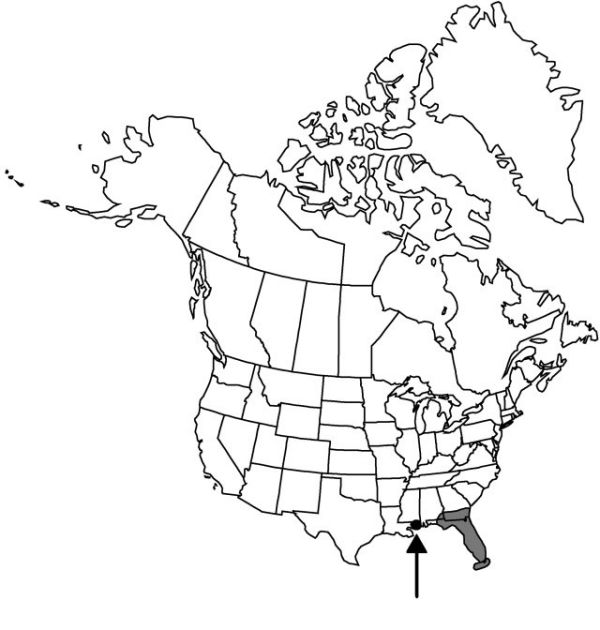Difference between revisions of "Sisyrinchium miamiense"
Bull. Torrey Bot. Club 26: 226. 1899.
FNA>Volume Importer |
imported>Volume Importer |
||
| (5 intermediate revisions by 2 users not shown) | |||
| Line 6: | Line 6: | ||
|place=26: 226. 1899 | |place=26: 226. 1899 | ||
|year=1899 | |year=1899 | ||
| + | }} | ||
| + | |special_status={{Treatment/ID/Special_status | ||
| + | |code=E | ||
| + | |label=Endemic | ||
}} | }} | ||
|basionyms= | |basionyms= | ||
| Line 11: | Line 15: | ||
|name=Sisyrinchium flagellum | |name=Sisyrinchium flagellum | ||
|authority=E. P. Bicknell | |authority=E. P. Bicknell | ||
| + | |rank=species | ||
}} {{Treatment/ID/Synonym | }} {{Treatment/ID/Synonym | ||
|name=Sisyrinchium recurvatum | |name=Sisyrinchium recurvatum | ||
|authority=E. P. Bicknell | |authority=E. P. Bicknell | ||
| + | |rank=species | ||
}} | }} | ||
|hierarchy=Iridaceae;Sisyrinchium;Sisyrinchium miamiense | |hierarchy=Iridaceae;Sisyrinchium;Sisyrinchium miamiense | ||
| Line 37: | Line 43: | ||
-->{{#Taxon: | -->{{#Taxon: | ||
name=Sisyrinchium miamiense | name=Sisyrinchium miamiense | ||
| − | |||
|authority=E. P. Bicknell | |authority=E. P. Bicknell | ||
|rank=species | |rank=species | ||
| Line 51: | Line 56: | ||
|publication title=Bull. Torrey Bot. Club | |publication title=Bull. Torrey Bot. Club | ||
|publication year=1899 | |publication year=1899 | ||
| − | |special status= | + | |special status=Endemic |
| − | |source xml=https:// | + | |source xml=https://bitbucket.org/aafc-mbb/fna-data-curation/src/2e0870ddd59836b60bcf96646a41e87ea5a5943a/coarse_grained_fna_xml/V26/V26_740.xml |
|genus=Sisyrinchium | |genus=Sisyrinchium | ||
|species=Sisyrinchium miamiense | |species=Sisyrinchium miamiense | ||
Latest revision as of 21:16, 5 November 2020
Herbs, perennial, brownish or bronze-olive when dry, to 4 dm, not glaucous; rhizomes slightly elongated. Stems branched, with 1 or 2 nodes, 1.3–2(–2.5) mm wide, glabrous, margins usually entire, similar in color and texture to stem body; first internode 9–30 cm, equaling or shorter than leaves; distalmost node with 1–3 branches. Leaf blades glabrous, bases not persistent in fibrous tufts. Inflorescences borne singly; spathes green to occasionally purplish, obviously wider than supporting branch, glabrous, keels usually entire; outer 12.5–23 mm, 2.3 mm shorter to 3.7 mm longer than inner, tapering evenly towards apex, margins basally connate 3.9–6.5 mm; inner with keel straight to evenly curved, hyaline margins 0.1–0.3 mm wide, apex acute or obtuse, ending at or to 1 mm proximal to aristate green apex. Flowers: tepals pale blue to deep bluish violet, bases yellow; outer tepals 8.3–12.8 mm, apex rounded to emarginate or truncate, aristate; filaments connate ± entirely, stipitate-glandular basally or glabrous; ovary similar in color to foliage. Capsules dark brown or nearly black, ± globose to obovoid, 3.7–4.5 mm; pedicel ascending to spreading. Seeds globose to obconic, lacking obvious depression, 1–1.2 mm, rugulose. 2n = 32.
Phenology: Flowering late winter–summer.
Habitat: Roadside ditches, hammocks, open woods
Elevation: 0–50 m
Distribution

Ala., Fla., Ga., Miss.
Discussion
Selected References
None.